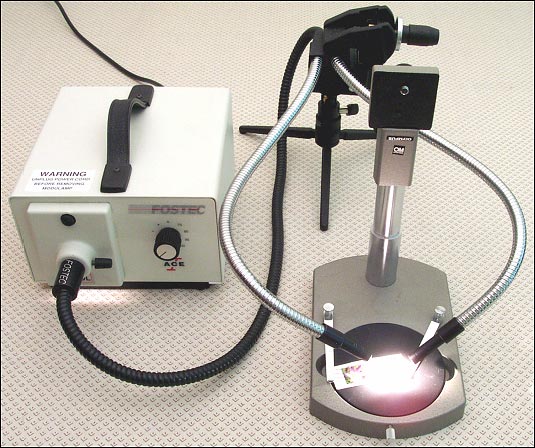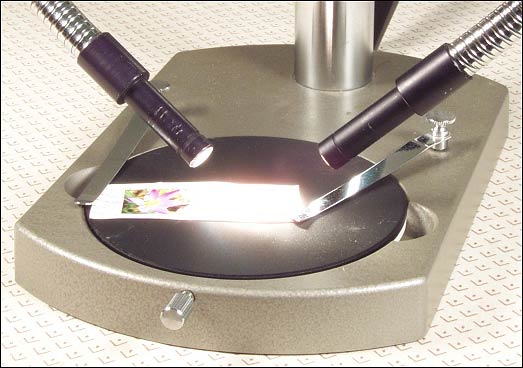Close-up and macro photography for entomologists
Lighting – Fibre optics
Fibre optic illuminators consist of a light source and one or more flexible light guides through which the light is transmitted to the subject, and are often used with stereo microscopes and in machine vision applications as well as for photography. They normally use a tungsten halogen bulb with a built-in dichroic reflector that allows much of the heat to pass through. A heat filter reduces the heat that passes into the light guides still further, so that very little heat reaches the subject even though the light is very bright.

Fostec Ace light source, with a Y-shaped light guide supported by a Manfrotto 035 Super Clamp on a Manfrotto 345 Table Top Kit.
The most common bulbs have the ANSI codes DDL, EKE and EJA, and are rated at 150 watts and 20–21 volts. A few models use a 250 watt bulb, which can be useful for high magnifications. There are also some models that use lower-rated bulbs, but these may not be sufficiently bright for high magnifications or for photography. Fibre optic lighting needs mains electricity.
The colour of the light usually needs to be adjusted for use with colour film. Some models can have a correcting filter added, either a dichroic filter inside the light source or a normal filter on the distal end of the arm, but these only provide proper correction at maximum intensity.
The light source has a rheostat to vary the intensity of the light, but this also changes the colour of the light, which becomes redder as it is made dimmer. Some of the more expensive models can also vary the intensity of the light using an iris diaphragm or a variable-width slit in the light source; these do not change the colour of the light. Some models accept a focusing lens or an iris diaphragm at the distal end of the arm, and these also allow the intensity of the light to be changed without affecting its colour. The light intensity can also be changed by moving the distal end of the arms nearer to or further away from the subject.
The light guides can be single or with up to 4 branches, and can be either flexible but limp, or self-supporting goosenecks. A common configuration for both photography and microscopy is a V-shaped arrangement of 2 self-supporting guides that are attached to the light source. If the guides are not self-supporting, then some sort of clamp will be needed to hold them in the desired position. Light guides are also available with an illuminated ring or a flat panel at the distal end.
Filters (including polarising filters) can be attached to the distal end of some light guides, and dichroic colour filters can used inside the light source.
Fibre optic lighting provides a controllable light source, and can be very useful for showing up fine structures, because the light can be made to come from very small apertures that can be brought very close to the subject, so showing up features by casting shadows.

A few models allow an electronic flash to be used as an alternative light source, and if the flash is dedicated to the camera then automatic exposure is possible.
A fibre optic light source with a single flexible light guide can often be adapted to provide illumination for microscopes for which bulbs are no longer available, by arranging the guide so that its distal end is in the location originally occupied by the filament of the bulb.
Send comments or questions to Alan Wood
![]()
![]()
Created 27th December 1997 — Updated 16th August 2007
Copyright © 1987–2007 Alan Wood